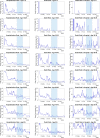COVID-19 underreporting and its impact on vaccination strategies
- PMID: 34711190
- PMCID: PMC8552982
- DOI: 10.1186/s12879-021-06780-7
COVID-19 underreporting and its impact on vaccination strategies
Abstract
Background: Underreporting cases of infectious diseases poses a major challenge in the analysis of their epidemiological characteristics and dynamical aspects. Without accurate numerical estimates it is difficult to precisely quantify the proportions of severe and critical cases, as well as the mortality rate. Such estimates can be provided for instance by testing the presence of the virus. However, during an ongoing epidemic, such tests' implementation is a daunting task. This work addresses this issue by presenting a methodology to estimate underreported infections based on approximations of the stable rates of hospitalization and death.
Methods: We present a novel methodology for the stable rate estimation of hospitalization and death related to the Corona Virus Disease 2019 (COVID-19) using publicly available reports from various distinct communities. These rates are then used to estimate underreported infections on the corresponding areas by making use of reported daily hospitalizations and deaths. The impact of underreporting infections on vaccination strategies is estimated under different disease-transmission scenarios using a Susceptible-Exposed-Infective-Removed-like (SEIR) epidemiological model.
Results: For the considered locations, during the period of study, the estimations suggest that the number of infected individuals could reach 30% of the population of these places, representing, in some cases, more than six times the observed numbers. These results are in close agreement with estimates from independent seroprevalence studies, thus providing a strong validation of the proposed methodology. Moreover, the presence of large numbers of underreported infections can reduce the perceived impact of vaccination strategies in reducing rates of mortality and hospitalization.
Conclusions: pBy using the proposed methodology and employing a judiciously chosen data analysis implementation, we estimate COVID-19 underreporting from publicly available data. This leads to a powerful way of quantifying underreporting impact on the efficacy of vaccination strategies. As a byproduct, we evaluate the impact of underreporting in the designing of vaccination strategies.
Keywords: Epidemiological models; Numerical simulation; Stable rates of hospitalization and death; Underreported infections; Underreporting estimation; Vaccination strategies.
© 2021. The Author(s).
Conflict of interest statement
All authors declare no competing interests.
Figures






References
-
- Gibbons C, Mangen M-J, Plass D, Havelaar A, Brooke R, Kramarz P, Peterson K, Stuurman A, Cassini A, Fèvre E, et al. Measuring underreporting and under-ascertainment in infectious disease datasets: a comparison of methods. BMC Public Health. 2014;14(1):1–17. doi: 10.1186/1471-2458-14-147. - DOI - PMC - PubMed
-
- Demonbreun AR, McDade TW, Pesce L, Vaught LA, Reiser NL, Bogdanovic E, Velez MP, Hsieh RR, Simons LM, Saber R, Ryan DT, Ison MG, Hultquist JF, D’Aquila Wilkins RT JT, Mustanski B, McNally EM. Patterns and persistence of SARS-CoV-2 IgG antibodies in Chicago to monitor COVID-19 exposure. JCI Insight. 2021 doi: 10.1172/jci.insight.146148. - DOI - PMC - PubMed
-
- Stadlbauer D, Tan J, Jiang K, Hernandez MM, Fabre S, Amanat F, Teo C, Arunkumar GA, McMahon M, Capuano C, Twyman K, Jhang J, Nowak MD, Simon V, Sordillo EM, van Bakel H, Krammer F. Repeated cross-sectional sero-monitoring of SARS-CoV-2 in New York City. Nature. 2021;590(7844):146–150. doi: 10.1038/s41586-020-2912-6. - DOI - PubMed
-
- Muñoz-Medina JE, Grajales-Muñiz C, Salas-Lais AG, Fernandes-Matano L, López-Macías C, Monroy-Muñoz IE, Santos Coy-Arechavaleta A, Palomec-Nava ID, Duque-Molina C, Madera-Sandoval RL, et al. Sars-cov-2 igg antibodies seroprevalence and sera neutralizing activity in Mexico: a national cross-sectional study during 2020. Microorganisms. 2021;9(4):850. doi: 10.3390/microorganisms9040850. - DOI - PMC - PubMed
MeSH terms
Grants and funding
- OAICE-CAB-02-022-2016/Universidad de Costa Rica (UCR)
- 01/2020/Instituto Butanta
- 305544/2011-0/Conselho Nacional de Desenvolvimento Cientifico e Tecnologico - CNPq
- 307873/2013-7/Conselho Nacional de Desenvolvimento Cientifico e Tecnologico - CNPq
- E-26/202.927/2017/Fundacao Carlos Chagas Filho de Amparo `a Pesquisa do Estado do Rio de Janeiro
LinkOut - more resources
Full Text Sources
Medical
Research Materials

